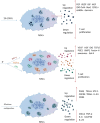Mesenchymal stromal cells-exosomes: a promising cell-free therapeutic tool for wound healing and cutaneous regeneration
- PMID: 31890717
- PMCID: PMC6933895
- DOI: 10.1186/s41038-019-0178-8
Mesenchymal stromal cells-exosomes: a promising cell-free therapeutic tool for wound healing and cutaneous regeneration
Erratum in
-
Corrigendum to: 'Mesenchymal stromal cells-exosomes: a promising cell-free therapeutic tool for wound healing and cutaneous regeneration'.Burns Trauma. 2020 Jan 23;8:tkaa007. doi: 10.1093/burnst/tkaa007. eCollection 2020. Burns Trauma. 2020. PMID: 32341920 Free PMC article.
Abstract
Cutaneous regeneration at the wound site involves several intricate and dynamic processes which require a series of coordinated interactions implicating various cell types, growth factors, extracellular matrix (ECM), nerves, and blood vessels. Mesenchymal stromal cells (MSCs) take part in all the skin wound healing stages playing active and beneficial roles in animal models and humans. Exosomes, which are among the key products MSCs release, mimic the effects of parental MSCs. They can shuttle various effector proteins, messenger RNA (mRNA) and microRNAs (miRNAs) to modulate the activity of recipient cells, playing important roles in wound healing. Moreover, using exosomes avoids many risks associated with cell transplantation. Therefore, as a novel type of cell-free therapy, MSC-exosome -mediated administration may be safer and more efficient than whole cell. In this review, we provide a comprehensive understanding of the latest studies and observations on the role of MSC-exosome therapy in wound healing and cutaneous regeneration. In addition, we address the hypothesis of MSCs microenvironment extracellular vesicles (MSCs-MEVs) or MSCs microenvironment exosomes (MSCs-MExos) that need to take stock of and solved urgently in the related research about MSC-exosomes therapeutic applications. This review can inspire investigators to explore new research directions of MSC-exosome therapy in cutaneous repair and regeneration.
Keywords: Cutaneous regeneration; Exosomes; Mesenchymal stromal cell; Microenvironment; Wound healing.
© The Author(s) 2019.
Conflict of interest statement
Competing interestsThe authors declare that they have no competing interests.
Figures


Similar articles
-
MSC-exosome: A novel cell-free therapy for cutaneous regeneration.Cytotherapy. 2018 Mar;20(3):291-301. doi: 10.1016/j.jcyt.2017.11.002. Epub 2018 Feb 9. Cytotherapy. 2018. PMID: 29434006 Review.
-
Mesenchymal stem cell-derived exosomes: A novel and potential remedy for cutaneous wound healing and regeneration.World J Stem Cells. 2022 May 26;14(5):318-329. doi: 10.4252/wjsc.v14.i5.318. World J Stem Cells. 2022. PMID: 35722196 Free PMC article. Review.
-
Exosomes derived from mesenchymal stem cells: A promising cell-free therapeutic tool for cutaneous wound healing.Biochimie. 2023 Jun;209:73-84. doi: 10.1016/j.biochi.2023.01.013. Epub 2023 Jan 18. Biochimie. 2023. PMID: 36681232 Review.
-
Exosomal microRNAs from Mesenchymal Stem Cells: Novel Therapeutic Effect in Wound Healing.Tissue Eng Regen Med. 2023 Aug;20(5):647-660. doi: 10.1007/s13770-023-00542-z. Epub 2023 May 2. Tissue Eng Regen Med. 2023. PMID: 37131016 Free PMC article. Review.
-
The Therapeutic Potential of Human Umbilical Cord Mesenchymal Stromal Cells Derived Exosomes for Wound Healing: Harnessing Exosomes as a Cell-free Therapy.J Stem Cells Regen Med. 2024 May 31;20(1):14-23. doi: 10.46582/jsrm.2003003. eCollection 2024. J Stem Cells Regen Med. 2024. PMID: 39044811 Free PMC article. Review.
Cited by
-
Diagnostic and Therapeutic Roles of Extracellular Vesicles in Aging-Related Diseases.Oxid Med Cell Longev. 2022 Aug 8;2022:6742792. doi: 10.1155/2022/6742792. eCollection 2022. Oxid Med Cell Longev. 2022. PMID: 35979398 Free PMC article. Review.
-
Full-Thickness Oral Mucoperiosteal Defects: Challenges and Opportunities.Tissue Eng Part B Rev. 2022 Aug;28(4):813-829. doi: 10.1089/ten.TEB.2021.0044. Epub 2022 Jan 24. Tissue Eng Part B Rev. 2022. PMID: 34409870 Free PMC article. Review.
-
Bottom-Up Assembly of Bioinspired, Fully Synthetic Extracellular Vesicles.Methods Mol Biol. 2023;2654:263-276. doi: 10.1007/978-1-0716-3135-5_17. Methods Mol Biol. 2023. PMID: 37106188
-
Exosomes for Wound Healing: Purification Optimization and Identification of Bioactive Components.Adv Sci (Weinh). 2020 Oct 27;7(23):2002596. doi: 10.1002/advs.202002596. eCollection 2020 Dec. Adv Sci (Weinh). 2020. PMID: 33304765 Free PMC article.
-
Latest advance anti-inflammatory hydrogel wound dressings and traditional Lignosus rhinoceros used for wound healing agents.Front Bioeng Biotechnol. 2024 Nov 28;12:1488748. doi: 10.3389/fbioe.2024.1488748. eCollection 2024. Front Bioeng Biotechnol. 2024. PMID: 39703792 Free PMC article. Review.
References
-
- Blanco Juan F., Graciani Ignacio F., Sanchez-Guijo Fermin M., Muntión Sandra, Hernandez-Campo Pilar, Santamaria Carlos, Carrancio Soraya, Barbado Maria-Victoria, Cruz Graciela, Gutierrez-Cosío Silvia, Herrero Carmen, San Miguel Jesus F., Briñon Jesus G., del Cañizo Maria-Consuelo. Isolation and Characterization of Mesenchymal Stromal Cells From Human Degenerated Nucleus Pulposus. Spine. 2010;35(26):2259–2265. doi: 10.1097/BRS.0b013e3181cb8828. - DOI - PubMed
Publication types
LinkOut - more resources
Full Text Sources

